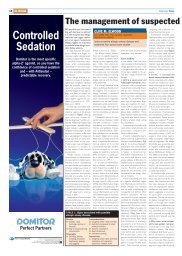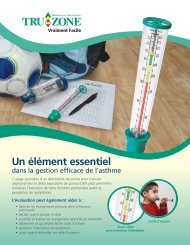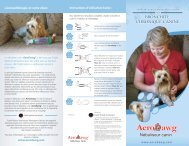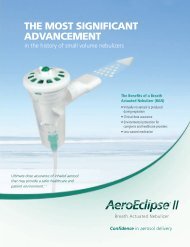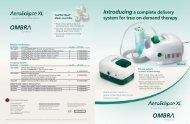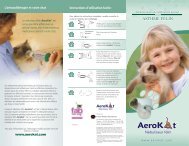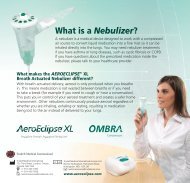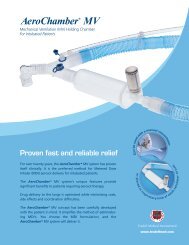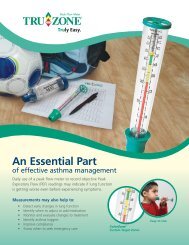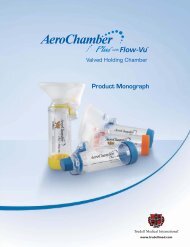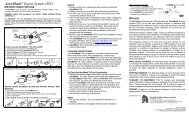AeroChamber Plus - Trudell Medical International
AeroChamber Plus - Trudell Medical International
AeroChamber Plus - Trudell Medical International
Create successful ePaper yourself
Turn your PDF publications into a flip-book with our unique Google optimized e-Paper software.
3Factors That Affect Aerosol Delivery From VHCsThree main factors affect aerosol delivery via a VHC: VHC characteristics, pMDI characteristics and thecharacteristics of the patient who uses the VHC.3.1 VHC CharacteristicsThe first generation of chambers, including GSK’s Volumatic † and AstraZeneca’s Nebuhaler † , were large volumedevices designed to accommodate the aerosol plume from CFC-formulated pMDIs. These plastic chambers wereconstructed of polycarbonate, a transparent material, which has been found to be prone to the accumulation ofelectrostatic charge. This accumulation of charge has been widely reported to cause aerosol to deposit on theinner surfaces of the VHC walls [Wildhaber, 1996; Dewsbury, 1996], reducing the fine particle mass availablefor inspiration. Although a ‘wash but don’t rinse’ procedure with ionic detergent has been shown to minimisethe build-up of electrostatic charge, the frequent washing suggested for maintenance of optimum VHCperformance may not be a practical expectation during routine clinical use. Thus, the variability in performanceof plastic VHCs may outweigh any small differences seen in the pharmaceutical performance between VHC devices.Some VHC devices such as Volumatic † incorporate heavy plastic one-way valves to prevent exhalation back intothe chamber. Patients with small lung volumes, such as infants, may not generate sufficient inspiratory flowrates to open these valves correctly [Kraemer, 1991; Barry, 1996b]. Modern small volume VHCs such as<strong>AeroChamber</strong> <strong>Plus</strong>* VHC with low resistance inspiratory valves may therefore be more appropriate for use ininfants and small children.The first truly portable, patient-friendly VHC was the <strong>AeroChamber</strong>* VHC which was developed at McMasterUniversity, Canada. It was designed to deliver the same lower respiratory tract dose of medication as the MDIalone when used under optimal conditions [Corr, 1982]. Since then new technologies and materials have becomeavailable and these too have been incorporated into the design of <strong>AeroChamber</strong>* VHC range. The<strong>AeroChamber</strong> <strong>Plus</strong>* VHC has incorporated aids such as the “EZ Flow” exhalation valve and theFLOWSIGnal* whistle, to assist appropriate inhalation patterns through the device. These VHCs are suppliedwith comfortable latex free ComfortSeal* facemasks for infants, children and adults to facilitate an effective sealbetween the VHC and face.3.2 pMDI CharacteristicsWhen a VHC is used in conjunction with a pMDI, it is important that the respirable mass of aerosol (i.e. theamount of the actuated dose that comprises particles small enough (



